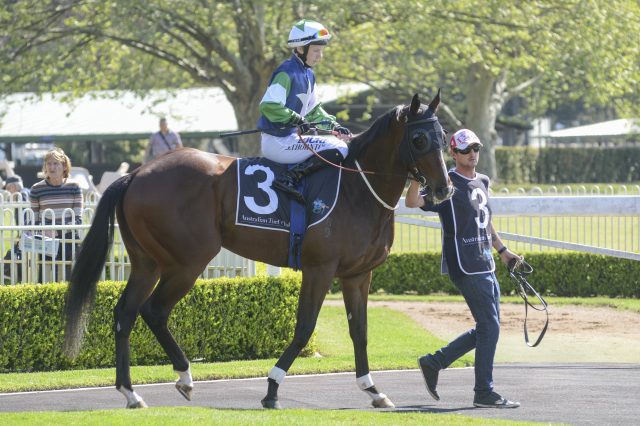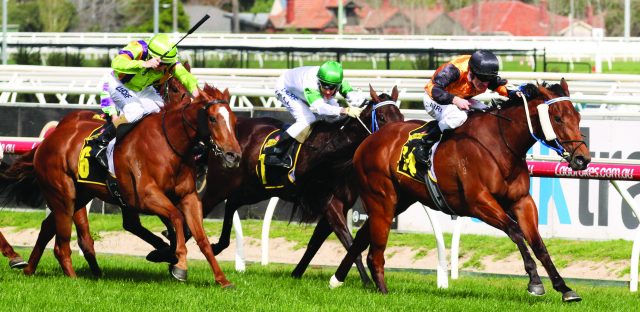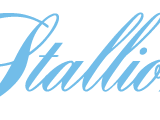[Published Bluebloods July/August 2020]
 After a humble beginning as a trainer seven years ago Henry Dwyer has developed quite a reputation for providing his owners with the most enjoyable and successful racing experience possible.
After a humble beginning as a trainer seven years ago Henry Dwyer has developed quite a reputation for providing his owners with the most enjoyable and successful racing experience possible.
The standard he has achieved is demonstrated by the tangible assets he has been able to build. With stabling at Caulfield, where he had 45 boxes, being closed by 2023 Henry has just completed construction of a state-of-the-art complex at Ballarat, 115km west of Melbourne. He has also had, for the last two years, a beach facility at St. Leonards on the Bellarine Peninsula south-west of Melbourne.
“Having the stabling at Ballarat, which is Victoria’s premier provincial training centre, and the place at St. Leonards gives us the flexibility to tailor each horse’s lifestyle to their individual needs,” Henry says. “I would have had to move from Caulfield in the next few years. Then we had twins in the spring of last year and as my wife Bec’s family is from Ballarat it was going to make things easier family-wise. We were always going to move to Ballarat anyway so we thought we would do that now rather in a year or two’s time. Virtually everything we have at Caulfield we’ve moved to Ballarat. We have our own private block of land next to the racecourse so we have our own track, treadmill and everything else there. There is also access to the track so we have the best of both worlds being able to use the very good facilities at Ballarat and having our own property as well. Besides Ballarat is a thriving racing centre, so it’s good to be there. We will keep the farm at St. Leonards as it is. There is a 1400m sand track around the property at St. Leonards, we have a treadmill and we can walk the horses down to the beach, which is just down the road so it’s all good.”
It is a tribute to Henry’s ability and work ethic that he has accomplished so much so quickly. Otherwise, to appease his family’s concerns, he could have been behind a desk in an office working as an accountant.
“I did accountancy at uni as part of my commerce degree, which was encouraged by my parents,” he says. My plan was to work hard for a few years in stables with various people, be training at the age of 27 or 28, which I was, and reach a decision on where I was heading by the time I was 30. If I hadn’t made a go of training by the time I was 30 I felt it wouldn’t be too late to go down another path but fortunately that didn’t happen.”
Rather ironically it was primarily through his father Michael and his grandfathers, who were enthusiastic punters, that Henry had his interest in the racing industry nurtured. He remembers that his father, who was a chartered accountant, would sit on the balcony of the family’s home in the Melbourne suburb of Glen Iris of a Saturday with a wireless, a form guide and a phone. By the time he was about eight Henry was having a few bets. Michael raced a number of horses including Count Grove, by Forest Glow (USA), who won at his debut and followed up by taking the VRC A.R.Creswick Stakes-LR at his second outing. Unfortunately Count Grove went amiss after that but as Henry says “at least he was a stakes winner”.
Another notable winner for him was Tinamou, by Quest For Fame (GB), whose victories featured the Warrnambool Cup-LR in 2011. With his father having horses in training that meant trips to the races and to the stables of Russell Cameron, Robert Smerdon and Brendan McCarthy. “It was enough to get me interested,” he says. “I was about 12 or 13 when the internet came into my life. I would sit on that for hours on end studying the stud book website, which was one of the earliest racing websites. I’d go back through the pedigrees and I loved doing that from day one, but at that stage I didn’t have any hands-on involvement.”
On leaving the prestigious Xavier College at 17 he undertook a course in commerce at Melbourne University. “I was living on campus, just down the road from Flemington,” he says. “I needed some sort of a job, working in a pub or whatever to finance what I was doing. Anyway I decided to go down to Flemington and found jobs working for Russell Cameron and Robert Smerdon mucking out boxes and what not. I was at uni for five years and during those five years I worked in the stables every morning.”
“As time went by I graduated from mucking out boxes to saddling up horses, walking them down to the track, strapping at the races and that sort of thing. By the time I finished uni I was reasonably proficient.” After completing his degree Henry elected to spend 12 months working on the Johnson family’s Ealing Park Stud, at Euroa.
It was the era when Ealing Park was standing Good Journey (USA), Special Bond and the 1990 VRC Melbourne Cup-Gr.1 winner Kingston Rule, who was nearing his retirement.
“The best part of being at Ealing Park was that it was a relatively small stud with stallions, mares, foals, yearling preparations and everything else,” he says. “That gave me a pretty good cross section of it all rather than being pigeon-holed in one area, as I would have been had I gone to a bigger stud. I had a great year there. It was good fun and I really enjoyed living out of the city.”
His stay at Ealing Park ended after reading an advertisement about Marcus Oldham College, which is an agricultural, equine and farm management tertiary education institution near Geelong.
“I thought I would apply for a scholarship at Marcus Oldham, was accepted and I did that for a year,” he says. It was while at Marcus Oldham that Henry met his wife Rebecca, who was also a student at the college and this led through to their marriage. They now have three children – Violet, who is nearing three, and twins Max and Harriet, who were born in September. Before having the children Bec had also been actively involved in racing, training “a couple” at Ballarat and doing pre-training. During his stay at Marcus Oldham Henry secured a picnic trainers’ licence and was able to “train and stable a couple of slow ones” on the college grounds.
“I just had two or three runners in the year, in the bush at the picnics,” he says. Once his term at Marcus Oldham was completed he re-joined Robert Smerdon’s operation at Caulfield. The star of the stable was the Fastnet Rock filly Mosheen, who finished second to Sepoy in the ATC Golden Slipper Stakes-Gr.1 in 2011. Mosheen, whose other victories featured the VRC Australian Guineas, Storm Queen Stakes and Randwick Guineas at the elite level, bolted away with the VRC Oaks-Gr.1 as a spring three year-old.

Around that time Henry was having negotiations with leading owner Lloyd Williams. Impressed by the way Henry had handled a radio interview, Williams – another Xaverian – sent a text inviting him to inspect his Macedon Lodge property, where a high quality team of imported gallopers was in work. This led through to a proposal to become assistant trainer to Robert Hickmott. “I discussed the offer with Robert Smerdon and his view was that I would be mad not to accept,” Henry says.
“I met Lloyd and his son Nick at their offices in South Melbourne and everything went well.” He began working at Macedon Lodge in February of 2012 but it turned out to be a time of sadness with his father dying prematurely just after he started in his new position. As he says “it was a difficult year” but he was cheered by the stable’s victory with the Montjeu gelding Green Moon (IRE) on the first Tuesday in November.
Soon after, with Lloyd’s blessing, I went on an overseas tour visiting the main racing and training centres in England, Ireland and France. “I travelled around to all the racing and training hot spots,” he says. “I spent time with John Oxx and Criquette Head and I went to Ballydoyle. then saw the major training centres at Newmarket, The Curragh and Chantilly and Manton and Lambourn and those sorts of places. I visited Dubai and Hong Kong on my way home. “It was great to see the sites, to meet the leading trainers and to see the European stryle of training in practice.”
“When I came back I thought I would give training a go and was able to sub-lease four boxes at Caulfield. When I started there were only three horses in work but I was very lucky early.” In preparation for the day when he began training in his own right Henry Dwyer Racing had bought a colt by Elusive Quality (USA) for $NZ80,000 at a New Zealand Bloodstock sale in April of 2011. Racing as Prelusive Strike he registered Henry’s first success as a trainer at a night meeting at Cranbourne on March 28 of 2013.
Accepting advice from Robert Smerdon’s valued yearling selector Merrick Staunton as well as having support from friends of his father and old school friends he was able to purchase six horses. Four of them were yearlings, one of which died from an attack of colic, while the other two were tried horses. “The three yearlings we raced were either stakes winners or city winners,” he says. “The best of them was Lucky Liberty.” After being victorious at Mornington at his debut on December 28 of 2014 Lucky Liberty, who was by Statue of Liberty (USA), went on to score at his next two outings.
Lucky Liberty, who was triumphant in the MRC Christmas Stakes-LR on Boxing Day of 2016, returned $281,850 on his purchase price of $17,000.
In the meantime Henry had cemented his reputation in the training ranks with three significant interstate forays. His confidence was bolstered when the Hussonet (USA) gelding Mendivil, who was bought as a tried horse, won a 2200m event at Warwick Farm on September 11 of 2013. “We got Mendivil as a tried horse and the day he won in Sydney he beat horses trained by Bart Cummings, Chris Waller and Gai Waterhouse,” he says. “That made me feel that I wasn’t going to embarrass myself as a trainer.” Two months later he struck the jackpot when he purchased Sonntag, by Teofilo (IRE) from the Strategic mare Parfaits who had been unplaced in three outings, for $58,000 at an Inglis sale at Oaklands. “Godolphin, or Darley as I think it was then, had 15 or 16 horses going through the ring,” Henry says. “I’d done the form and replays on all of them and Sonntag was a progressive horse, who hadn’t been overly taxed and I felt would be suited over a distance. I bid on another lot before him, but he went to a price we couldn’t afford.
“Then I bought Sonntag and if I hadn’t bought him I’d have bought another horse afterwards, which didn’t do a lot.” However, the association with Sonntag began badly when he suffered an infected tendon sheath in a hind leg and was “in the Ballarat Veterinary Clinic on death’s door for three or four weeks”. Around eight months went by before he was able to race. He broke his maiden second up at Sale the following April and earned a shot at the BRC Queensland Derby-Gr.1 by winning over 2000m at Caulfield in May. Sent out a $13 chance in the Derby he was able, with Chad Schofield in the saddle, to edge out Pinstripe Lane to earn a cheque for $325,000. By his retirement Sonntag’s prize winnings had risen to $641,795 and had been a “terrific” horse for his connections. “He was just the type of horse I needed when I was kicking off and propelled me to a decent level by winning my first Group 1,” Henry says. At that stage he was able to expand – taking over boxes released on Peter Moody’s decision to stand down – and horses “began flooding through the door”.

Amongst them was the speedy Econsul (NZ) mare Precious Gem, who impacted the “snowballing effect” by winning the MRC Anniversary Vase-LR on April 16 of 2016 and then the SAJC Robert Sangster Stakes-Gr.1 three weeks later. “Precious Gem was a six-year-old mare when she arrived and for her to win the Robert Sangster and give me my second Group 1 in the space of three years was great,” he says.
“We had gone from four to 18 to 40 boxes at Caulfield in the first couple of years, which was very manageable. We’ve got into a groove and have kept ticking along since that with a steady stream of winners and city winners.” These have featured SAJC Adelaide Cup-Gr.2 winner Annus Mirabilis, other Gr.2 winners in La Falaise and Snitty Kitty, Gr.2 and Gr. 3 winner Legless Veuve, Gr.3 winners in Beirut, Crown Witness, Ms Catherine and Property, Super VOBIS winners If Not Now When and Rocky Boomboa plus Don’t Blush Baby a winner of the grey’s race on V.R.C. Oaks Day.
“It’s all been working well so we are confident about the future,” he says.



